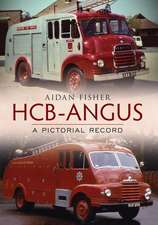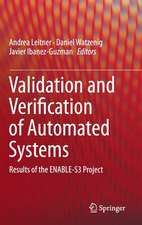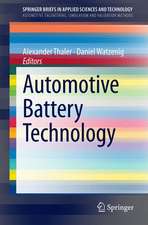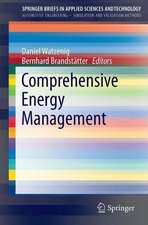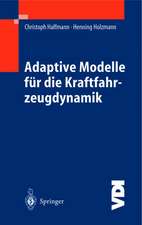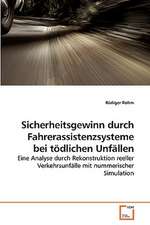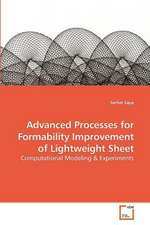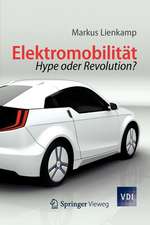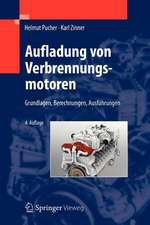Automated Driving: Safer and More Efficient Future Driving
Editat de Daniel Watzenig, Martin Hornen Limba Engleză Paperback – 14 iun 2018
The current state of the art of automated vehicle research, development and innovation is given. The book also addresses industry-driven roadmaps for major new technology advances as well as collaborative European initiatives supporting the evolvement of automated driving. Various examples highlight the state of development of automated driving as well as the way forward.
The book will be of interest to academics and researchers within engineering, graduate students, automotive engineers at OEMs and suppliers, ICT and software engineers, managers, and other decision-makers.
| Toate formatele și edițiile | Preț | Express |
|---|---|---|
| Paperback (1) | 1671.56 lei 6-8 săpt. | |
| Springer International Publishing – 14 iun 2018 | 1671.56 lei 6-8 săpt. | |
| Hardback (1) | 2012.14 lei 6-8 săpt. | |
| Springer International Publishing – 4 oct 2016 | 2012.14 lei 6-8 săpt. |
Preț: 1671.56 lei
Preț vechi: 2038.49 lei
-18% Nou
Puncte Express: 2507
Preț estimativ în valută:
319.84€ • 333.98$ • 264.12£
319.84€ • 333.98$ • 264.12£
Carte tipărită la comandă
Livrare economică 15-29 aprilie
Preluare comenzi: 021 569.72.76
Specificații
ISBN-13: 9783319811468
ISBN-10: 3319811460
Ilustrații: XVII, 620 p. 255 illus., 171 illus. in color.
Dimensiuni: 155 x 235 mm
Greutate: 0.97 kg
Ediția:Softcover reprint of the original 1st ed. 2017
Editura: Springer International Publishing
Colecția Springer
Locul publicării:Cham, Switzerland
ISBN-10: 3319811460
Ilustrații: XVII, 620 p. 255 illus., 171 illus. in color.
Dimensiuni: 155 x 235 mm
Greutate: 0.97 kg
Ediția:Softcover reprint of the original 1st ed. 2017
Editura: Springer International Publishing
Colecția Springer
Locul publicării:Cham, Switzerland
Cuprins
Part 1. Introduction .- 1. Introduction to automated driving.- 2. Privacy and security in autonomous vehicles.- 3. Automated driving from the view of technical standards.- Part 2. The importance of control for automated driving.- 4. Survey on control schemes for automated driving on highways.- 5. Path tracking for automated driving: a tutorial on control system formulations and ongoing research.- 6. Vehicle reference lane calculation for autonomous guidance control.- Part 3. Advances in environment sensing, sensor fusion, and perception.- 7. The role of multi-sensor environmental perception for automated driving.- 8. Galileo-based advanced driver assistance systems - key components and development.- 9. Digital maps for driving assistance systems and autonomous driving.- 10. The history – how it all began – radar sensors in cars.- Part 4. In-vehicle architectures and dependable power computing.- 11. System architecture and safety requirements for automated driving.- 12. Advanced system-level design for automated driving.- 13. Systems engineering and architecting for intelligent autonomous sys-tems.- 14. Open dependable power computing platform for automated driving.- Part 5. Active and functional safety in automated driving.- 15. Active safety towards highly automated driving.- 16. Functional safety of automated driving systems: Does ISO 26262 cover the challenges.- Part 6. Validation and testing of automated driving functions.- 17. The new role of road testing for the safety validation of automated vehicles.- 18. Validation of highly automated safe and secure systems.- 19. Testing and validating tactical behavior planning for automated driving.- 20. Safety performance assessment of assisted and automated driving in traffic: simulation as knowledge synthesis.- 21. From controllability to safety in use - safety assessment of driver assis-tance systems.- 22. Testing autonomous and highly configurable systems – challenges and feasible solutions.- Part 7. A sampling of automated driving research projects and initiatives.- 23.AdaptIVe.- 24. Drive Me.- 25. FUSE.- 26. AutoNet2013.- 27. ARCHER.- 28. ASSUME.- 29. UFO – Ultraflat overrunable robot for experimental ADAS testing.- 30. ITS Corridor.- 31. European and national initiatives.- 32. ARTEMIS Industrial Association.- 33. ERTRAC.- 34. SafeTRANS.- 35. A3PS.
Notă biografică
Daniel Watzenig was born in Austria. He received his Master degree in electrical engineering and the doctoral degree in technical science from Graz University of Technology, Graz, Austria, in 2002 and 2006, respectively. He is currently divisional director of the automotive electronics and embedded software department of the Virtual Vehicle Research Center in Graz. Since 2009 he is an Associate Professor at the Institute of Electrical Measurement and Measurement Signal Processing, Graz University of Technology, Austria. He is author or co-author of over 120 peer-reviewed papers, book chapters, patents, and articles. His research interests focus on sensor fusion and signal processing, automotive control systems, uncertainty estimation, and robust optimization methods. In 2005 he was a visiting researcher at the University of Auckland, New Zealand, working on multi-sensor arrays and statistical signal processing. In 2011 he was visiting researcher and guest lecturer at the Federal University of Rio de Janeiro. He is IEEE Senior Member of the IEEE Control Systems, Signal Processing and Instrumentation & Measurement Societies. Furthermore, he is Vice President and member of the steering board of the EU ARTEMIS Industrial Association.
Martin Horn was born in Austria. He received his Master degree in electrical engineering and the doctoral degree in technical science from Graz University of Technology, Graz, Austria, in 1992 and 1998, respectively. From 2003 to 2008 he was is an Associate Professor at the Institute of Automation and Control at Graz University of Technology. From 2008 to 2014 he was full professor for Control and Mechatronic Systems at Klagenfurt University. Since 2014 he is full professor for Automation and Control at Graz University of Technology. He is author or co-author of around 100 peer-reviewed papers, book chapters, patents, and articles. His research interests focus on automotive control systems, robust control, variable structure systems and robust observer design.
Martin Horn was born in Austria. He received his Master degree in electrical engineering and the doctoral degree in technical science from Graz University of Technology, Graz, Austria, in 1992 and 1998, respectively. From 2003 to 2008 he was is an Associate Professor at the Institute of Automation and Control at Graz University of Technology. From 2008 to 2014 he was full professor for Control and Mechatronic Systems at Klagenfurt University. Since 2014 he is full professor for Automation and Control at Graz University of Technology. He is author or co-author of around 100 peer-reviewed papers, book chapters, patents, and articles. His research interests focus on automotive control systems, robust control, variable structure systems and robust observer design.
Textul de pe ultima copertă
The main topics of this book include advanced control, cognitive data processing, high performance computing, functional safety, and comprehensive validation. These topics are seen as technological bricks to drive forward automated driving.
The current state of the art of automated vehicle research, development and innovation is given. The book also addresses industry-driven roadmaps for major new technology advances as well as collaborative European initiatives supporting the evolvement of automated driving. Various examples highlight the state of development of automated driving as well as the way forward.
The book will be of interest to academics and researchers within engineering, graduate students, automotive engineers at OEMs and suppliers, ICT and software engineers, managers, and other decision-makers.
The current state of the art of automated vehicle research, development and innovation is given. The book also addresses industry-driven roadmaps for major new technology advances as well as collaborative European initiatives supporting the evolvement of automated driving. Various examples highlight the state of development of automated driving as well as the way forward.
The book will be of interest to academics and researchers within engineering, graduate students, automotive engineers at OEMs and suppliers, ICT and software engineers, managers, and other decision-makers.
Caracteristici
Discuss the emerging topic of automated driving from the viewpoint of academia and from industrial perspective
Provides a seamless coverage of all relevant systems for automated driving, their integration and their reliability assurance
Current state-of-the art will be extensively discussed and both progressive and conservative short-/mid-/long-term road maps will be considered
Provides a seamless coverage of all relevant systems for automated driving, their integration and their reliability assurance
Current state-of-the art will be extensively discussed and both progressive and conservative short-/mid-/long-term road maps will be considered


